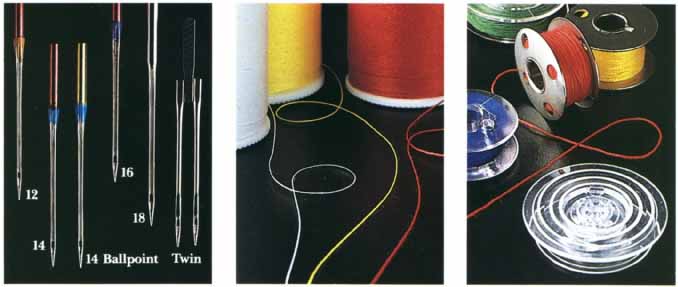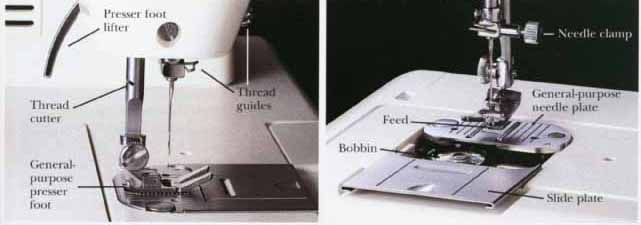A sewing machine is your most important piece of sewing equipment, so select one with care. A sturdy, well-built machine will give you many years of sewing enjoyment.
If you are buying a new machine, there are a variety of models available to fit any budget or sewing need. Types range from a basic zigzag with one or two built-in stitches, to the electronic machine that uses advanced computer technology to control and select the stitching.
Available features include built-in buttonholer, color-coded stitch selection, instant reverse, snap-on presser foot, free arm for stitching small round areas (such as pants legs), built-in bobbin winder, automatic tension and pressure adjustment, and automatic stitch length adjustment. Each feature usually adds to the cost of the machine, so look for a machine to match your sewing projects. Buy a machine that satisfies your sewing needs, but don’t pay for features you will rarely use. Also consider the amount and difficulty of the sewing you do, and the number of people you sew for. Talk to fabric store personnel and friends who sew. Ask for demonstrations, and try out and compare several models. Look for quality workmanship and ease of operation as well as stitching options.
The machine’s cabinetry is another factor to consider. Portable machines offer the flexibility of moving to various work surfaces. Machines built into cabinets are designed to be the right height for sewing. They also help you stay organized by providing a convenient place to store sewing equipment and keep it handy.
Although sewing machines vary in capabilities and accessories, each has the same basic parts and controls. The equipment you will need for your machine is described here.
The principal parts of the sewing machine (below) are shown on a free-arm portable, but its basic parts are representative of all machines. Check your manual for specific location of these parts on your machine.
Machine Essentials
Needles (above left) are available in four basic types: general-purpose for a wide range of fabrics, in sizes 9/65 (finest) to 18/110; ballpoint for knits and stretch fabrics (size 9/65 to 16/100); twin needle for decorative stitching; and wedge-point (not shown) for leather and vinyl. Change the needle after sewing two to three garments or after hitting a pin. Damaged fabric is often caused by a bent, blunt or burred needle.
Thread (above center) for machine sewing comes in three weights: extra fine for lightweight fabrics and machine embroidery, all-purpose for general-purpose sewing, and topstitching and buttonhole twist for decorative and accent stitching. Thread should match the weight of the fabric and the size of the needle. For perfect tension, use the same size and type thread in the bobbin as you use in the needle.
Bobbins (above right) may be built-in or removable for
winding. Bobbins with a built-in case are wound in the case. Removable
bobbins have a removable bobbin case with a tension adjustment screw.
They may be wound on the top or side of the machine. Start with an empty
bobbin-so the thread will wind evenly. Do not wind it too full or the
bobbin thread will break.
Major Parts of the Sewing Machine
- Take-up lever
- Bobbin winder tension disk
- Handle
- Spool cap
- Bobbin winder spindle
- Hand wheel
- Stitch balance control dial
- Stitch length selector and buttonhole dial
- Reverse stitch push button
- Power and light switch (on back)
- Speed controller and electrical connections
- Stitch width selector
- Tension dial
- Extension bed
- Presser foot lifter
- Thread cutter
- General-purpose presser foot
- Bobbin
- Feed
- Needle clamp
- Slide plate
- General-purpose needle plate





